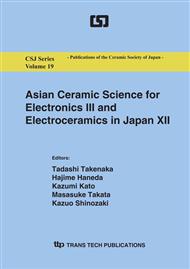p.123
p.127
p.131
p.135
p.139
p.143
p.148
p.153
p.157
Fabrication of Dielectric/Conductive Hybrid Artificial Superlattices Using Molecular Beam Epitaxy Method
Abstract:
Artificial super-lattices of [(BaTiO3)/(SrTiO3)10]4 (BTO10/STO10) were fabricated on STO(001) substrate by the molecular beam epitaxy method (MBE), and the molecular layers of SrRuO3(SRO) was introduced into these superlattices as conductive layers. The superlattices introduced two conductive layers showed the enormous dielectric permittivity. On the other hand, the permittivity of the superlattice introduced one conductive layer was almost same as that of BTO10/STO10. In the case of introducing two conductive layers, the moving electrons between two layers induced the interfacial polarization. Especially, the superlattice with two SRO conductive layers, the distance between these layers in a superlattice is 18 molecular layers, showed the highest relaxation frequency 132 kHz and biggest capacitance.
Info:
Periodical:
Pages:
139-142
Citation:
Online since:
December 2009
Price:
Сopyright:
© 2010 Trans Tech Publications Ltd. All Rights Reserved
Share:
Citation:


